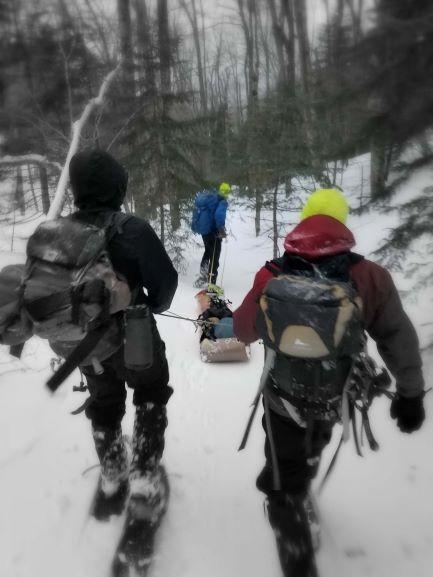- Tags:
- Recreation

With search and rescue missions increasing over the past few years, training (like that pictured, above) is critical.
It’s 9:30 p.m. and you’ve just finished tidying the house after putting your kids to bed when you suddenly receive a notification. This is not a drill — you have an hour to grab your ready-pack and get to the trailhead.
The details are fuzzy, but will become clear when you reach the staging area. You don’t know what has happened, and you don’t know when you’ll be back. All you know is somebody needs help, and you have volunteered.
If you are lost or injured in the forests and waters of New Hampshire, it is likely you would be assisted back to civilization and medical care by a dedicated team of Search and Rescue (SAR) volunteers, along with a Fish and Game conservation officer.
According to Lt. James Kneeland of Fish and Game, it can take 18 people to safely carry out an injured hiker, and upwards of 30 people with longer distances and rougher terrain. A trail that is casually hiked in under an hour by day can quickly become a late-night ordeal when rescue is needed.
It may seem like a rare and unlikely situation to be so injured or lost that a rescue is necessary, but in the last three years, there have been nearly 500 SAR missions in New Hampshire, including 165 in 2019 alone. Fish and Game cannot possibly handle all of that on its own, which is why, in addition to the outdoors clubs and organizations such as the Appalachian Mountain Club, there are eight regional volunteer SAR groups operating in New Hampshire.
These groups, made up of around 250 or so volunteers with a typical annual operating budget of around $5,000, are the meat and potatoes of SAR operations across the state. SAR team members assisted Fish and Game on 85 missions last year, committing 5,222 volunteer hours to the effort.

Members of volunteer SAR teams are highly trained risk managers who are mostly motivated by empathy and compassion rather than guts and glory. They take time away from their family and work obligations to assist those in need.
More than half of last year’s SAR missions to help lost and injured hikers occurred on rugged terrain in the White Mountain National Forest. There is no financial reward for SAR volunteers, and as a matter of fact, the team members are responsible for purchasing required gear and equipment, often pay dues, and use their own personal vehicles to get to and from the staging area.
Considered a form of “preventative search & rescue”, the White Mountain National Forest Trailhead Stewards Program is a more social-interactive version of mountain safety. Maybe you’ve seen them at popular trailheads like the Old Bridle Path in Franconia Notch.
These volunteer stewards aim to interact with hikers who might otherwise end up calling for help later on down the trail. Collectively, the group of 87 Trailhead Stewards put in 2,353 volunteer hours in 2019. Some Trailhead Stewards are former SAR members who can no longer physically carry out that rigorous role, but still have a desire to help others and protect our natural resources.
The stewards ask hikers seemingly simple but often overlooked questions like: “Do you know what time the sun goes down? Do you have a flashlight?” These probing questions encourage hikers of all experience levels to consider if they are prepared for when the unexpected occurs.
SAR isn’t cheap, and because of concerns of liability, the volunteer SAR groups only respond when directly contacted by Fish and Game.
Over the last three years, search and rescue missions cost Fish and Game well over half a million dollars, not including expenses for training and equipment. The department is funded by $1 from every boat, ATV and snowmobile registered in New Hampshire and by the purchase of hunting and fishing licenses.
Since 2015, the HikeSafe program — a sort of rescue insurance that hikers can buy for $25 a year — has helped to both educate the public and generate revenue for SAR operations. HikeSafe brought in more than $155,000 last year.
New Hampshire residents may ask, “Why should I pay for some dummy who gets lost in the woods?” As reported by the Outdoor Industry Association, outdoor recreation in New Hampshire generates $8.7 billion in consumer spending and $528 million in state and local tax revenue..
Even the most experienced and prepared hiker can slip and twist an ankle and be unable to complete a hike. If that happens, it’s good to know there’s a dedicated team of volunteers out there ready to help.

If you are interested in learning more about SAR teams in your area, and if you would like to make a contribution, visit www.nhoutdoorcouncil.org. The New Hampshire Outdoor Council is an independent nonprofit comprising outdoor professionals and managers that supports backcountry education, safety and search and rescue teams.
Andy Crowley is a program coordinator with the Society for the Protection of New Hampshire Forests, and a trustee member of the New Hampshire Outdoor Council. Reach Andy at acrowley@forestsociety.org
Originally published in the New Hampshire Union Leader on January 18, 2020.
